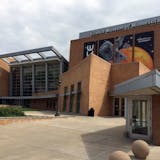A black-and-white map of North and South America hanging in the Minneapolis Institute of Art has no borders or cities. Instead, it is filled with the names of tribes of Indigenous people who occupied these lands long before European colonizers arrived.
"It is a way of kind of claiming the territory again for its Indigenous peoples and to say that they are alive, they exist among us today," said Valéria Piccoli, chair of the Arts of the Americas and curator of Latin American Art.
This reimagined borderless map, "Pueblos originarios del continente" ("Original peoples of the continent") by Mexico-born artists Carla Fernández and Pedro Reyes, sets the stage for "ReVisión: Art in the Americas," an exhibition that opened Saturday. The show uses a mix of ancient and contemporary works to consider the changing continents, effects of colonialism, environmental impacts and continually shifting cultural identities of the Americas today.
Nearly 130 artworks in the show come from the Denver Art Museum, but Piccoli, who became Mia's inaugural curator of Latin American art in November, added an additional 37 works from the museum's permanent collection. Some of those gems include Brazilian photographer Sebastião Salgado's documentary-style photographs of a gold rush in the village of Serra Pelada, where nearly 100,000 people mined from 1979 to 1986.
The show labels are in Spanish and English, and the galleries are each painted in different vibrant colors. Meandering through the exhibit feels like making discoveries while exploring a maze. The show is organized into broader themes around land, resources and cultural identity, and there are so many gems it is easy to get lost in the splendor.
'ReVisión' beginnings
When Piccoli arrived in Minneapolis from Brazil, where she had lived and worked her whole life, she noticed that the museum's Latin American collection felt "very disconnected." As Mia's first dedicated curator in this area, she'll be putting the pieces together, creating a connected narrative.
The "ReVisión" exhibition borrows work mostly from the Denver Art Museum, which has one of the country's most robust Latin American art collections, but there is also at least one piece from the Pérez Art Museum Miami.



